
6 stunning pairing ideas with Farfugiums
Our ideas to create beautiful combinations with the leopard plant
Contents
Often planted en masse to create lush carpets in the shade, the Farfugium japonicum or leopard plant can also lend itself to successful combinations. This evergreen perennial, with its unique rounded and glossy leaves, is renowned for its foliage, even though its subtle yellow flowering can also be appreciated at the end of summer. It is an absolutely magical plant for damp gardens, forming stunning groundcovers with an exotic appearance.
Discover our tips for successfully combining Farfugium in the garden or on the terrace!
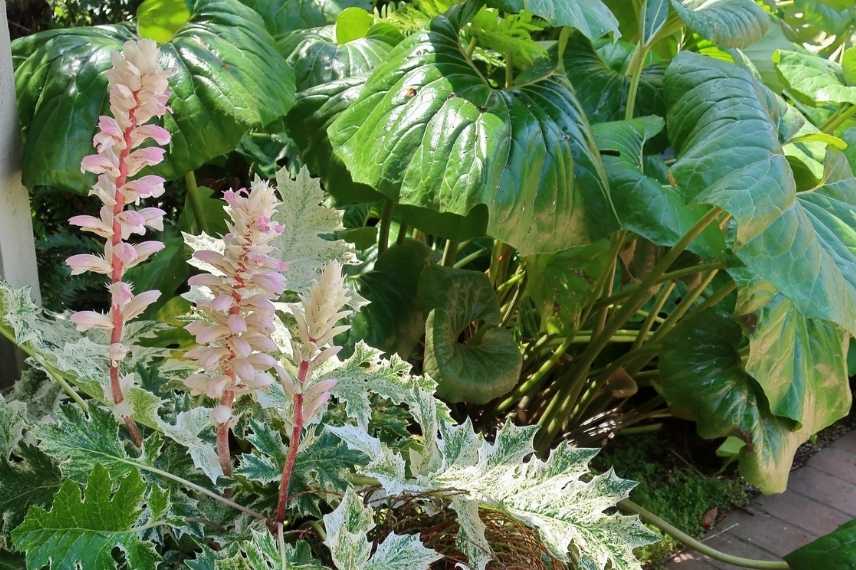
A beautiful and simple combination between a Farfugium ‘Gigantea’ and the Acanthus ‘Whitewater’ ( © Cultivar 413)
In an exotic scene
The large, glossy leaves of Farfugiums are perfect for integrating into a border or exotic area, paired with other large or distinctly styled foliage, like them. While this space will evoke a tropical escape, it is indeed through the choice of unusual and decidedly exotic foliage, primarily evergreen, that this is achieved. A few flowering plants can be added to enhance the tropical sensation.
For this jungle scene, the Farfugium giganteum is the most suitable: this variety has the largest leaves of the species, with a diameter approaching 50cm when it is happy and the soil remains sufficiently cool in summer. However, you can also play with the stunning spots of Farfugium japonicum ‘Aureomaculatum’ or the lovely variegation of the ‘Argenteum’ variety.
Plant at least one palmate or pinnate foliage such as a Sabal minor that thrives in low light, or in a mild climate, the exotic appeal of a Cycas revoluta. Also consider a large or unusual plant such as a tree fern, a Colocasia, a Gunnera manicata in a large border, or even a Tetrapanax, both of which will require a bit more sunlight. You can also add another plant with large rounded leaves, without placing it next to others, like the extravagant Astilboides tabularis that forms immense green plates. A few ferns will link the spaces; choose surprising ones like the stunning Coniogramme emeiensis or bamboo fern. In a large border, add other evergreen groundcovers: Rohdeas or Asarums for example. In terms of flowers, warm tones will be welcome in this almost tropical setting: Fritillarias raddeana (sufficiently in the sun) or a Euphorbia griffiti ‘Fireglow’ in spring, vibrant Digiplexis in summer, and for autumn appeal, a Mahonia confusa or a beautiful mass of Tricyrtis.
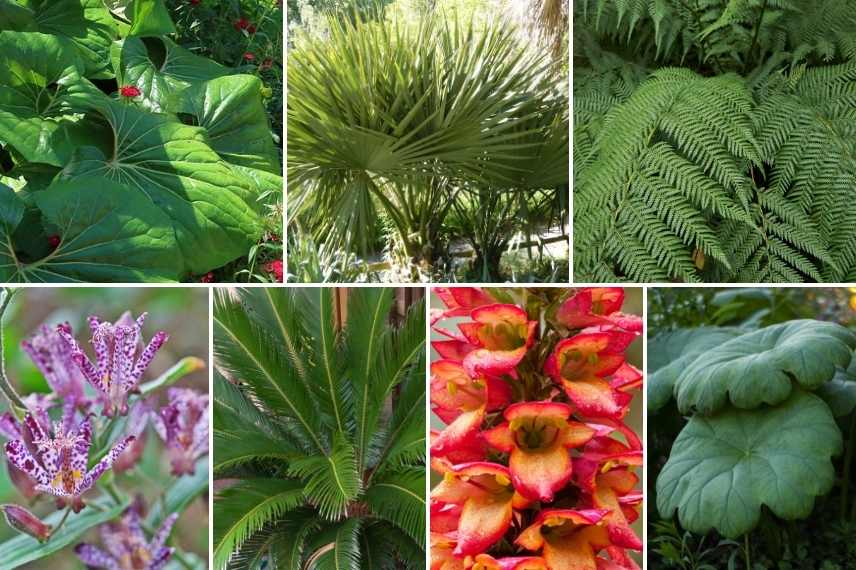
An exotic border allows Farfugiums to fully express themselves: here accompanied by a Sabal minor, a Dicksonia antarctica, Tricyrtis, a Cycas, the beautiful flowering of Digiplexis, and Astilboides tabularis
In a foliage bed
Enjoy the exuberance of Farfugiums to create a bed where foliage reigns supreme! In shade or partial shade, they provide a remarkable effect in this type of configuration, blending with contrasting textured foliage such as that of ferns or lanceolate, upright leaves. There is a wide selection of plants that thrive in cool, shaded soil. It is truly this play of contrast that we will emphasise, between differences in shapes, textures, and the infinite palette of greens to purples. Some flowering plants can add a touch of disruption, as long as they remain discreet.
While we can rely on all the exotic foliage mentioned above, let’s add the exceptional foliage of Fatsia japonica, luminous Hakonechloas, and Podophyllums with textured leaves. The Aspidistra eliator and hellebores are two magnificent evergreen perennials to adopt, also contrasting with the roundness of Farfugiums. Begonias grandis, Brunneras, and Alchemillas pair very well with the panther plant, just like a Carex ciliatomarginato ‘Shima Nishiki’.
Some Bergenias harmonise well with the roundness of their leaves, while in the least shaded spot, a beautiful acanthus and a clump of Zantedeschias aethiopica ‘Himalaya’ can be added to enhance the lushness. By planting some black Ophiopogons, heucheras, and a purple Japanese maple or a Loropetalum, you will bring the necessary dark touch to rhythm the entire bed.
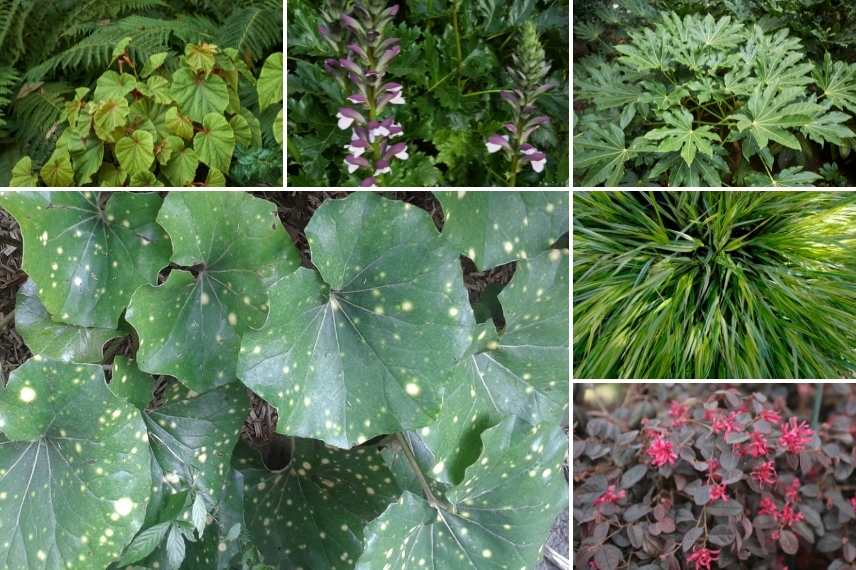
Farfugium japonicum ‘Auremaculatum’, Begonia grandis and ferns, Acanthus mollis, Fatsia japonica, Hakonechloa macra, Loropetalum ‘Hot spice’
Discover other Farfugium
View all →Available in 1 sizes
Available in 1 sizes
Available in 1 sizes
Available in 2 sizes
Available in 1 sizes
In a pot on the terrace
Generous in the garden, Farfugium can easily find its place in a large pot on a shaded terrace or patio in the city. By choosing a beautiful, tall pot, it becomes grand and irreplaceable, adding an exotic touch. It will then be part of a collection of beautiful foliage, while keeping the choice of plants limited to highlight it effectively. Notably, in a pot, the flamboyant ‘Wavy Gravy’ shines as a star on a balcony.
For example, you could create a small trio of pots with a Colocasia veined with purple, such as ‘Blue Hawai’ with its large, matte leaves drooping down, a beautiful clump of variegated, blue or light green hostas, and a dwarf bamboo like Sasa masamuneana ‘Albostriata’, variegated with cream: all three make for magnificent pot companions. An Aspidistra elatior with its stunning elongated leaves is another great option to contrast with the roundness of the Farfugium. If you want to introduce a more vibrant flowering than the discreet blooms of the hostas, opt for a hardy Fuchsia that will bloom abundantly throughout the summer, adding a beautiful splash of colour.
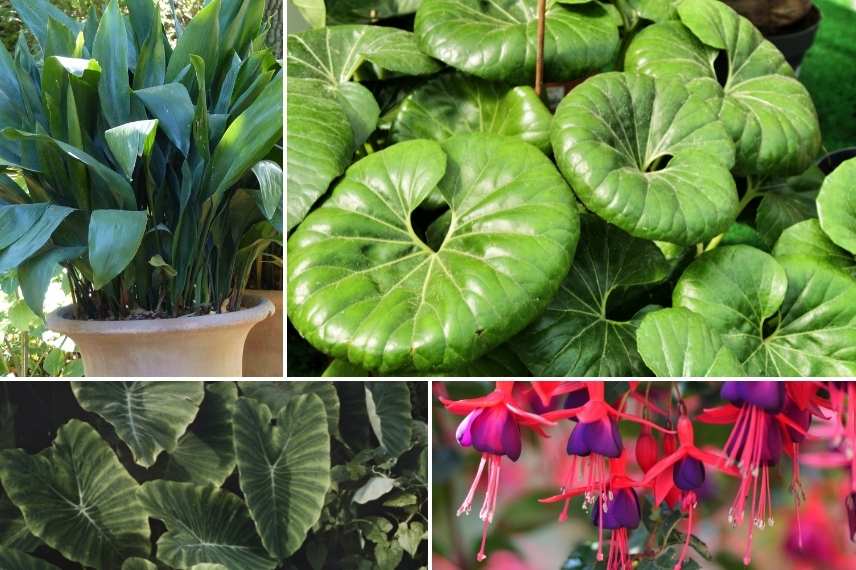
Aspidistra elatior, Farfugium japonicum, Colocasia and Fuchsia
Read also
5 large-leaved perennialsIn opulent borders
Growing to a maximum height of around 50 cm when choosing the typical species, Farfugium japonicum uniquely highlights shaded to semi-shaded borders. Its large, glossy leaves provide an effective and original evergreen base for edging paths and walkways. In an exotic garden, it’s even a lovely option to consider for replacing more traditional borders.
For this border use, farfugium benefits from being paired in twos with a perennial, a low grass, a dwarf bamboo, or a small trimmed bush, also selecting evergreen varieties: this could be a Geranium maderense in a mild climate for a contrast of foliage textures and a lovely spring flowering, a light green or purple heuchera for a strong colour alternation, or a Carex siderosticha ‘Variegata’ for an even more exotic effect. By interspersing these different plants, the rhythmic effect is perfectly assured. Other unusual pairs include farfugium and Cycas in southern regions or along the Atlantic coast (this can be done over small linear areas), farfugium paired with a compact Daphne, or farfugium and a Carex oshimensis ‘Everlime’ to play with the delicacy of this very elegant sedge.
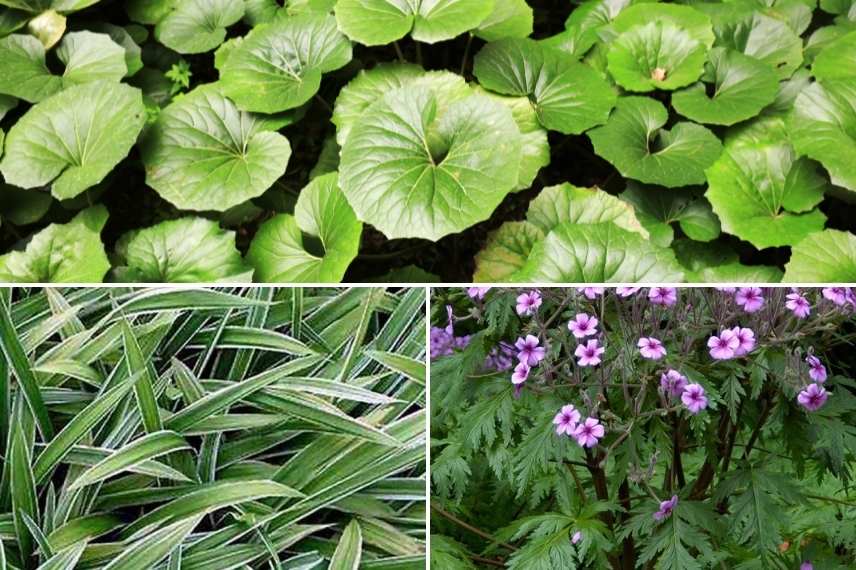
Farfugium japonicum, Carex siderosticha ‘Variegata’, Geranium maderense
In woodland
Eminently graphic, farfugium can also be combined with woodland perennials, a beneficial area for it as it meets all its requirements: shade, humus-bearing soil, coolness, and summer moisture with a layer of leaves. Under the cover of trees, it will help create a persistent carpet in a space often adorned with deciduous plants.
For a natural atmosphere, opt for plants native to Japan or Southeast Asia like it, thriving in moist soil: ground-covering perennials such as Kirengeshoma palmata will complement the yellow of its late summer flowering, while a few Codonopsis and Ophiopogons will add a distinctly Japanese grace, and several clumps of calanthes, these beautiful terrestrial orchids, will provide an exotic touch. To bring plenty of freshness in spring, Polygonatums (Solomon’s seal) with their lovely arching stems are perfect. In this type of space, numerous ferns suited to cool ground will fill the gaps: Matteuccia orientalis, Thelypteris palustris, Woodwardia, etc.
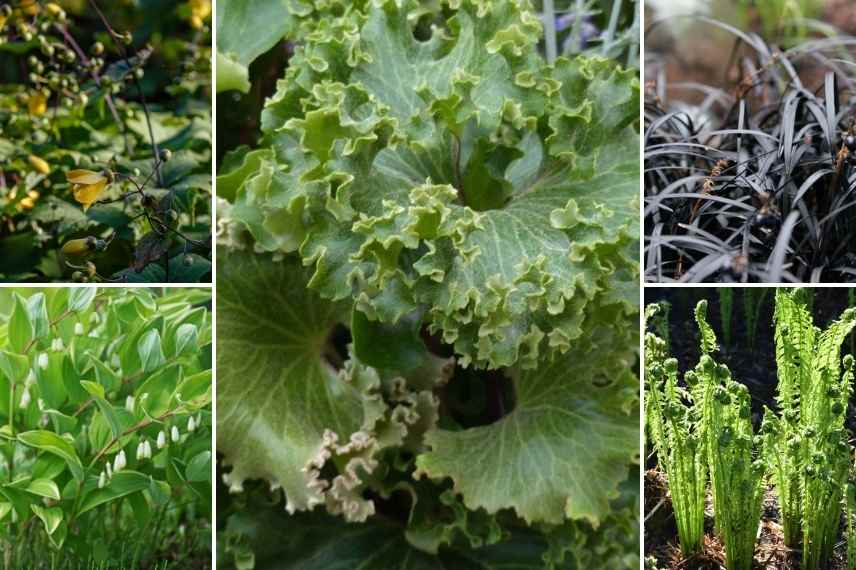
In the centre, Farfugium ‘Wavy Gravy’, surrounded by Kirengeshoma palmata, Polygonatums, Ophiogopons nigrescens, and Matteuccia struthiopteris
Around a pond
Don’t hesitate to invite a few feet of farfugiums near a pond or water feature: they will find ideal growing conditions there, with cool soil, and their large leaves will flourish beautifully alongside other bank or wetland plants. Vary the structures and shapes of foliage, for example by combining with the linearity of a Phalaris arundinacea ‘Picta’, variegated with cream, and the abundance of white or pink Filipendulas that will provide a misty pink flowering in summer. A structural plant like the remarkable Gunnera manicata – if you have enough space – or a Tetrapanax around a more limited area, will be magnificent. To accompany the yellow flowering of farfugiums at the end of summer, a beautiful mass of Ligularias dentata provides a sunny presence and also ensures a foliar carpet with very interesting purplish touches.
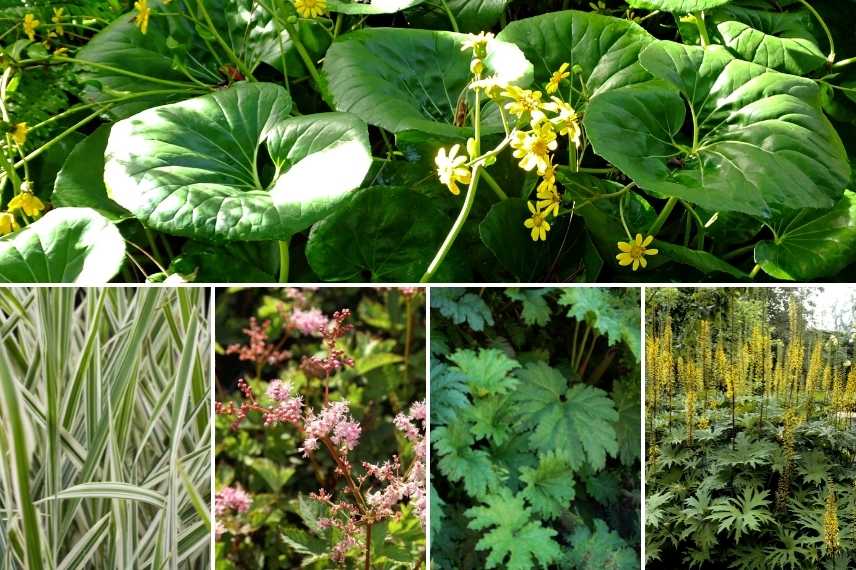
Farfugium around a water feature, associated with Phalaris arundinacea ‘Picta’, Filipendula ‘Kahome’, a Gunnera manicata, and a beautiful mass of Ligularia Przewalskii
- Subscribe!
- Contents
![[farfugium-partner] farfugium-partner](https://en.promessedefleurs.eu/blogwp/wp-content/uploads/2021/12/farfugum-associer.jpg)































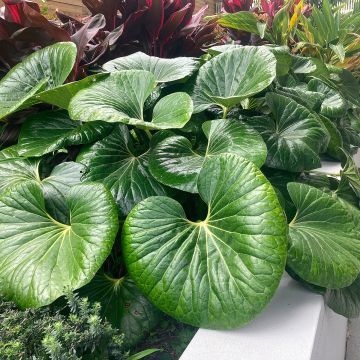
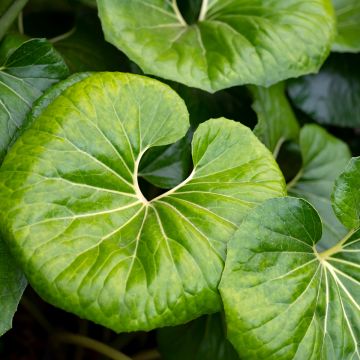
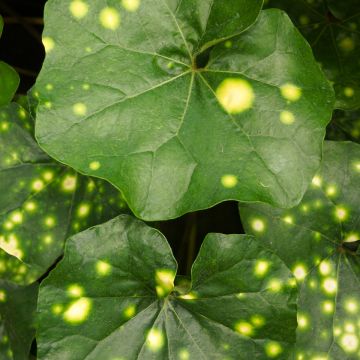


Comments